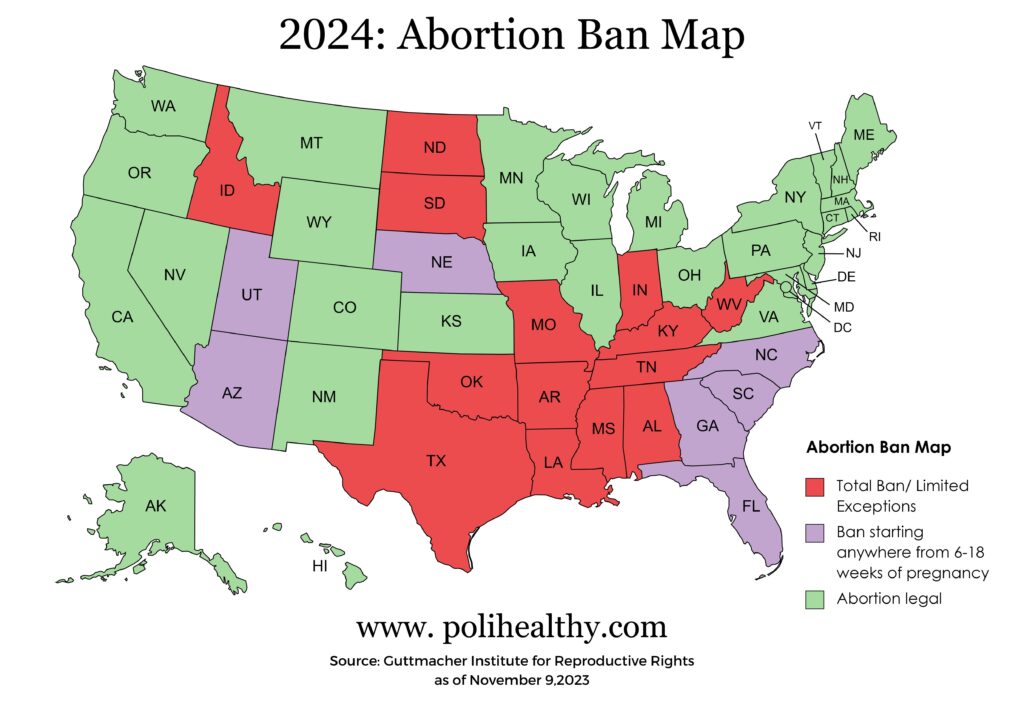Politics, Health Insurance, and Abortion: The Need for Comprehensive Reproductive Education
Table of Contents
- Politics, Health Insurance, and Abortion: The Need for Comprehensive Reproductive Education
- What is Abortion?
- Understanding the Relationship Between Politics and Abortion
- The Supreme Court & Abortion
- Abortion and the Question of When Human Life Begins
- Americans’ Views on Terminating a Pregnancy
- Health Insurance and Terminating a Pregnancy
- The Insurance through ACA Versus Medicaid Health Insurance
- Medicaid Health Insurance and The Debate Over Abortion Access
- Can Women Go to Other States to Terminate a Pregnancy Legally?
- The Impact of Politics and Health Insurance on Abortion Access
- The Importance of Comprehensive Reproductive Care
- Conclusion
In the abortion debate, it is important to understand the need for comprehensive reproductive education for individuals. By broadening our understanding and knowledge, we can empower individuals to make informed decisions about their reproductive well-being that consists of diverse needs that goes beyond abortion.
What is Abortion?
Abortion is the termination of a pregnancy by removing the fetus from the uterus, resulting in the death of the fetus. An abortion may occur spontaneously due to complications during pregnancy or can be induced (assisted by medication or surgery). An induced abortion is a procedure which aims to end a pregnancy.
According to Pew Research Center, in 2020 alone there were between 620,327 and 930,160 abortions performed. Abortion is a common procedure in the U.S.
The interconnection of politics, abortion and health insurance is complex, and warrants a deeper conversation that a soundbite. Health policies, political affiliation, beliefs and individual experiences shape the narrative as to whether the termination of a healthy pregnancy is necessary or whether it should remain legal.
In this blog, we will discuss the intricacies of terminating a pregnancy, healthcare and access. We will also look at the societal and political landscape when it comes to terminating a pregnancy. Most importantly, I will explain why it’s important for women and their families to have access to comprehensive reproductive education that goes beyond a single narrative.
Is Abortion Legal?
The laws regarding terminating a pregnancy vary widely from state to state. In states like New York and California, the termination of a pregnancy is legal and relatively easier to get. In other states, it is only legal in certain circumstances, such as when the mother’s life is in danger or when the pregnancy is the result of rape or incest. Only in a few states there is a total ban on ending a pregnancy.
The Abortion Debate

Terminating a pregnancy is a complex and controversial issue that is often intertwined with politics and health insurance.
In the United States, the debate over terminating a pregnancy has been raging for decades, with both sides of the issue holding strong beliefs. The political landscape and the health insurance system can both have a significant impact on access to terminating a pregnancy. It is important to understand the relationship among these three factors-politics, healthcare and abortion.
Understanding the Relationship Between Politics and Abortion

The political landscape in the United States is highly polarized on the issue of ending a pregnancy. The Democratic Party generally supports abortion rights, while the Republican Party generally opposes abortion. This polarization further permeates when laws demand religious institutions to support any federal and state abortion initiatives. This is so because more often than not, terminating a pregnancy is a moral issue for many.
Democrats typically support policies that expand access to ending a pregnancy, such as repealing the Hyde Amendment. The Hyde Amendment prohibits the use of federal funds to pay for elective abortions in most cases.
Republicans typically support policies that restrict access to abortion, such as parental notification laws, TRAP laws (Targeted Regulation of Abortion Providers) and the Hyde Amendment.
The Supreme Court & Abortion

The political climate can also have an impact on the appointment of judges to the Supreme Court. We now have one of the most conservative Supreme Court in US history, which is a legacy of the Trump Administration.
The Supreme Court has played a major role in shaping abortion laws in the United States. The views of the justices on termination of a pregnancy can have a significant impact on access to abortion.
For example, in 1973, the Supreme Court ruled in favor of Roe v. Wade, stating that the termination of a pregnancy is a constitutional right. However, on June 24, 2022, the Supreme Court overturned Roe v. Wade, which makes abortion illegal in many states.
Abortion and the Question of When Human Life Begins
Many conservatives agree that terminating a pregnancy is the ending of a human life. However, Democrats and Republicans alike can’t decide when human life begins. Some have stated human life begins at the time of conception, while some argue that it begins at six weeks. Vice President Harris claims human life begins at viability which is usually around 24 weeks. Is Vice President right?
As a healthcare professional who cared for premature babies for years, I must disagree with Vice President Harris. A fetal heartbeat can be heard as early as 6 weeks. A baby born at 24 weeks can survive outside the womb. But what about fetuses with a heart, skin and formed organs, should we discount this fetus as a nonliving entity, as many have stated?
It’s a complex question, with a tremendous burden of ethics and morals.
I am not a judge, but I have some thoughts as a clinician who have cared for mothers after a stillbirth or women who have chosen to terminate a pregnancy.
An abortion at 24 weeks is defined as a late-term abortion. All young women should know terminating a pregnancy is not without significant medical risks for the mother (especially in late-term terminations). According to the Centers of Disease and Prevention, abortions after 21 weeks’ gestation are rare.
Crisis Pregnancy Center: An Alternative to Abortions
I believe women should have every opportunity to choose life for their unborn children, especially if finances or housing are the primary issues. I also believe that abortion should be a last resort for women facing unplanned pregnancy under certain circumstances.
Locating a crisis pregnancy center can play an important role in helping women make this choice. I support funding for crisis pregnancy centers and encourage all women who are facing an unplanned pregnancy to reach out to one for help.
Crisis pregnancy centers provide free and confidential counseling and support to women who are facing unplanned pregnancies. They can help women explore all their options, not just terminating their pregnancy. These centers also offer resources about adoption and parenting.
Americans’ Views on Terminating a Pregnancy
According to the Pew Research Center, although 62% of Americans agree that women should have access to induced termination in most cases, they disagree whether terminations should occur in all cases. Most Americans disagree with terminations occurring in the third trimester, only a mere 19% do.

Furthermore, the CDC reports over 90% of termination of pregnancies occur in the first trimester. Year after year since the 1980s, most women have sought elective abortions in the first trimester, not in the third trimester of pregnancy. Those fighting for late-term elective induced terminations are not in the majority.
Once again, the public is made to believe that late term abortions are common, when the data shows that it is not. The role of political debates and sensational stories can paint an inaccurate picture and cloud the facts.
But I am a strong proponent of hearing both sides of the story and making an informed decision about your health and your future. Currently, many states still offer pregnancy termination, despite the rhetoric. The likelihood of termination via an abortion pill before 6 weeks has less requirements than obtaining procedural termination as the weeks go by.
Health Insurance and Terminating a Pregnancy
Health insurance can also play a great role in access to abortion services.
In the United States, most health insurance plans are employer-provided. This means that the employer decides what services are covered by the plan. Some employers may choose to exclude abortion coverage from their health insurance plans.
In recent years, employers who exclude abortion coverage have faced backlash for their decision. However, our constitution protects the decision of these businesses. Businesses have a right to exclude these services, especially if it goes against their company mission and religious liberties.
For any woman who needs to terminate a pregnancy, it is best to research the company’s mission and values in regard to their employees’ reproductive health. Likewise, it is beneficial for everyone to have health insurance with access to comprehensive reproductive health services.
The Insurance through ACA Versus Medicaid Health Insurance
The Affordable Care Act (ACA) requires most health insurance plans to cover preventive care services for women.
However, the ACA does not require health insurance plans to cover abortion services. This means that even if a woman has health insurance through the marketplace, she may not have coverage for terminating a pregnancy.
The lack of health insurance coverage for terminating a pregnancy can make it difficult for women to afford the cost of this service. However, companies like Microsoft, Disney and Netflix have donated to organizations to help women with the out- of -pocket costs associated with elective terminations.

A 2022 article in the Journal of Health Affairs states that the average cost of medically ending a pregnancy in the United States is around $ 560. The maximum income limit for a Medicaid recipient in 2023 is $2747. Therefore, an out-of-pocket cost for terminating a pregnancy would be around 20% of their income.
Let’s put this in context: Financial experts like Dave Ramsey suggest that people should allocate 10-12% of their income to groceries per month. Twenty percent (20%) would be around 2 months’ worth of groceries. A 2021 survey by the Federal Reserve Board states that around one-third of Americans can’t cover an emergency of $400 or more. Chances are most Medicaid recipients can’t cover the average cost of terminating a pregnancy.
But the question remains…
Should the government or private health insurance through ACA cover the costs of pregnancy termination under all circumstances?
Medicaid Health Insurance and The Debate Over Abortion Access
Many conservatives argue that the cost of elective terminating a pregnancy should not be the responsibility of the government or state. It comes down to a matter of reproductive responsibility, and not merely abortion rights. Medicaid and government funded health insurance limits access to abortion services.
Government Insurance and Abortion Access
I am yet to find a persuasive argument that has convinced the government to allocate tax dollars for pregnancy termination, outside of the three scenarios mentioned above. The federal government has taken a hard stance against supporting tax funded pregnancy termination under all circumstances for decades.

Income & Abortion Access
Proponents of abortion rights argue that abortion law disproportionately burden the poor and limits access. However, even women with private health insurance may have to pay for pregnancy termination services out-of-pocket. If their private insurance doesn’t cover these services or it’s illegal in their state, similar to women receiving Medicaid Health Insurance- they also must cover the cost of terminating the pregnancy.
Let’s disband the myth that all women with private insurance have elective abortion covered.
In fact, there is no way to tell if your private insurance covers induced termination of a pregnancy just by looking at the insurance card. You must read the coverage benefits of your insurance, call your insurance provider to find out or choose the best health insurance plan to cover your healthcare needs.
Abortion Access for Federal Employees
I will never forget when a federal employee came into my office begging for an abortion for her 16-year-old daughter. Even though OBGYN services and contraceptives are covered under the federal insurance, civil servants and their dependents will not get coverage for elective termination of pregnancies under federal insurance.
Despite the overturn of Roe v Wade, a majority of states still have provisions for legal abortions. States with strict policies will allow abortions in the case of rape, incest, and a mother’s right to live.
Can Women Go to Other States to Terminate a Pregnancy Legally?
The short answer is yes and no.

Women who are considering traveling to another state for an abortion should check with their insurance company to see if their plan covers ending a pregnancy in other states. If the private health insurance through the employer does not cover the ending a pregnancy across state lines, they must pay out of pocket for the procedure.
The cost of terminating a pregnancy varies depending on the state, the provider, and the type of abortion procedure. Very few states criminalize women who travel out of state for procedures under a physician’s care. However, if the woman obtains an abortion pill without the consent of a medical doctor or licensed prescriber, especially in a state where abortion pills are restricted, it may be illegal, and she may face federal charges.
The Impact of Politics and Health Insurance on Abortion Access
The intersection of politics and health insurance can have a significant impact on the access to terminating pregnancies. The political climate can influence the policies that are enacted, which can have a direct impact on access to these services.

One of the primary concerns against abortion bans is that it works for the affluent and not the marginalized. Moreover, many believe that abortion clinics are disproportionally operating in minority communities and low-income areas. But research shows that clinics operate in both urban and rural communities. Those that operate in urban areas serve both urban and rural populations, requiring travel for some residents.
Political ideologies and political figures often shape the narrative and sentiment surrounding terminating a pregnancy.
However, the overarching factor for abortion services is supply and demand.
The US healthcare system operates on a business model. Therefore, abortion clinics operate in areas that will make the most financial sense- whether that’s urban or rural.
Abortion Health Policies Shaped by Politics
Federal law only allows federal funding for abortions in cases of rape, incest, or life endangerment of the mother, as I mentioned before. As a result, most states limit Medicaid coverage for the termination of a pregnancy to these circumstances. On the other hand, most employer-based private insurance cover abortion services.
The following are some specific examples of how politics and health insurance can impact abortion access:
- Medicaid restrictions: Many states have restrictions on the use of Medicaid to pay for abortions. Low-income women need to pay for elective abortions out of pocket.
- Parental notification laws: Some states have laws that require minors to obtain permission from a parent or guardian before terminating a pregnancy. In addition, a judge can rule in favor of abortion for teenagers in certain circumstances.
- Targeted Regulation of Abortion Providers (TRAP): Are laws that place regulations on abortion providers.
- Employer-provided health insurance: Some employers may choose to exclude coverage terminating pregnancies from their health insurance plans.
The Importance of Comprehensive Reproductive Care
Understanding the interconnected pieces of comprehensive reproductive healthcare is crucial in navigating the often-polarized abortion debate. It’s not just about a single procedure; it’s about empowering women to make informed choices throughout their reproductive journeys.
Comprehensive reproductive care is like a puzzle, each piece plays a vital role in shaping a woman’s reproductive health and well-being.
Post Abortion Care
Instead of solely focusing on the narrow lens of terminating a pregnancy, public figures must champion the importance of holistic care. Health policies and laws should work to equip women with the knowledge and tools to make informed decisions about their bodies and families. Abortion might be a critical piece, but it’s just one element within the larger picture.
Post-abortion care deserves a prominent seat at the table too. Every woman has the right to understand the process, potential risks, and alternative options. This is the essence of comprehensive care: providing complete support beyond a single event.
I will never forget when a woman told me she was still grieving the termination of a pregnancy she had two decades ago. These are untold stories that will never make it on our TV. She and many women like her need grief therapy and other supportive services. This is what comprehensive care promises to women who were unaware of the emotional trauma that can happen after a pregnancy termination.
Family Planning & Comprehensive Reproductive Care
Family planning services play another crucial role in preventing unwanted pregnancies, which is another piece of the puzzle. Investing in public health education on this front can significantly empower women.
An internal study by the Population Reference Bureau demonstrates this positive impact and highlight how family planning services can contribute to women’s overall well-being. We should not overly emphasize terminating a pregnancy as an easy family planning alternative; there are less invasive ways that safer for the mother to achieve the family planning goals she desire.
Comprehensive family planning services equip individuals and couples with the knowledge and tools they need to plan their families. Individuals should be taught this in high school. It is undeniably the best thing we can do to empower them.
Access to counseling on various contraceptive methods, fertility awareness, and preconception care empower individuals to make informed decisions about childbearing and reproductive health optimization.
By embracing this broader perspective, we can move beyond the polarized abortion debate and towards a future where women are truly empowered to make informed choices about their reproductive lives. This comprehensive approach fosters not just individual well-being, but also stronger families and communities.
Conclusion
The relationship between politics, health insurance, and abortion is complex and multifaceted. The political climate, the health insurance system, and the actions of individual employers can all have a significant impact on access to abortion.
In most states, elective termination of pregnancies is still legal. However, access to abortion has decreased in recent years. This is due to several factors, including making abortion illegal in certain situations and the Supreme Court’s decision to overturn Roe v. Wade.
Many employer-based health insurance plans cover abortion services, even in states where the termination of a pregnancy is severely restricted or illegal. This allows some women to travel to other states to obtain abortion care, even if it is not available in their home state.
The overturn of Roe v. Wade has challenged many young women and men to reconsider issues regarding reproductive responsibility.
Pro-life opponents of abortion have argued that mandating federal funding for elective termination of pregnancies should not be done arbitrarily, but with much consideration, and I wholeheartedly agree. From a fiscal standpoint, the Hyde Amendment has saved the United States billions of dollars.
The issue of terminating a pregnancy is likely to remain a contentious one in the United States for many years to come. It is important to have a nuanced understanding of the complex relationship between politics, health insurance, and abortion so that we can all make informed decisions about these issues.
We must strive to find a reasonable solution to this controversial issue. So far, comprehensive reproductive offers a reasonable long-term solution to the abortion issue. Women must be empowered during every phase of their reproductive journey, whether single or not. Comprehensive reproductive health emphasizes on education and making informed healthcare decisions.
I look forward to a time when all women will feel empowered to make educated decisions about their reproductive health.
Sources
Guttmacher Institiute
Guttmacher Institute: https://www.guttmacher.org/
Pew Research Center
Nadeem, R. (2023, April 26). Views of abortion access increasingly vary by where Americans live | Pew Research Center. Pew Research Center – U.S. Politics & Policy. https://www.pewresearch.org/politics/2023/04/26/nearly-a-year-after-roes-demise-americans-views-of-abortion-access-increasingly-vary-by-where-they-live/
Planned Parenthood
https://www.plannedparenthood.org/
National Abortion Federation
Health Affairs
The Federal Reserve
Bloomberg
Bass, D. (2022, August 3). Microsoft donations to Anti-Abortion groups targeted by activist. Bloomberg.com. https://www.bloomberg.com/news/articles/2022-08-03/microsoft-donations-to-anti-abortion-groups-targeted-by-activist
The Hollywood Reporter
Keegan, R. (2022, June 24). The Hollywood Reporter. The Hollywood Reporter. https://www.hollywoodreporter.com/news/politics-news/roe-v-wade-netflix-disney-1235171423/
According to the Centers for Disease Control and Prevention
Population Research Bureau
Family Planning and the Gendered Impacts of Crises on Women: an effective tool across sectors to support women’s empowerment and build resilience to shocks. (n.d.). PRB. https://www.prb.org/resources/family-planning-and-the-gendered-impacts-of-crises/


